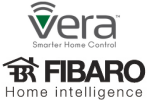A few weeks ago I wrote about Home automation and The Internet of Things (IoT).
TL;DR version: The Internet of Things is already here – and in a big way, but it’s in disguise as “Home Automation”. Not every device needs to be connected directly to the internet. Being connected to a gateway to the internet – a controller – is more than sufficient. In fact, it’s better because the controller can automate all kinds of scenes without being dependent on your internet connection. The dominant protocol for in-house communications is z-wave. The gateway presents z-wave devices as IP-based devices.
I ended that post saying there are two companies that I think can potentially dominate the market for controllers. So without further ado:
The two companies that have the potential to emerge as the victor in the controller market are Fibaro, with its Home Center range. And Vera with its, er, Vera products.
They are very different companies – both wanting to sell you the main controller that sits as the hub of your home network of things.
Fibaro Home Center 2
Fibaro are a Polish company distributing to 30 countries. As well as the controller, they also make devices (motion/light detectors, smoke alarms, relays, etc) that are compatible with other Z-Wave controllers.
The design of their hardware and software is Apple-esque, even down to the packaging. It’s all done very beautifully. But like Apple, they don’t seem to play well with others. Their controller doesn’t lend itself well to being customised and extended by customers.
Vera 3
Vera are based in Hong Kong and focus solely on their controller product which is based on the MIOS platform.
Their brand and website have recently undergone a much-needed revamp as they re-branded from their former name of Micasaverde. But the new look hasn’t filtered through to their products yet. The interface is clunky at best and it could never be accused of being user friendly. But what it lacks in looks it makes up for in functionality and ‘hackability’.
As customers are writing and sharing their own extensions and plugins it has become far more useful than Fibaro. Vera, thanks to its developer community, can connect to and control your Sonos system and, through an extra piece of hardware, lots of non Z-Wave devices.
The latter is a massive selling point as it means you can use the Vera system to manage LightwaveRF sockets and switches as well as many other (very affordable) devices that are out of reach of the Fibaro system.
If Fibaro are Apple, then Vera is Android.
If Fibaro is MacOS, then Vera is Unix.
Taking Fibaro for a spin
At the time that I finished my previous post I’d been using the Vera controller at home. I’d done a lot of research but what eventually swayed me in favour of the Vera over Home Center was the support for other devices and the availability of community-created plugins.
I wasn’t disappointed. I got up and running very quickly and connected a whole range of devices. The big problem though was the Wife Acceptance Factor (WAF – not my shorthand, so don’t shout at me, ladies!). The UI is butt ugly. And the constant waiting for it to reload is bloody annoying to say the least.
I decided that if I was going to write about Vera vs Fibaro then I ought to get my hands on a Home Center 2 and give it a go. Most of the Fibaro retailers have a very generous returns policy so it’s easy to play with devices and send them back if they’re not to your liking.
I can’t overstate the difference between the two systems. Home Center 2 is slick, easy to use and a joy to work with. In contrast, the Vera feels like a hacked together school science project. The lack of direct control of LightwaveRF and other 433 Mhz devices is still a huge negative (I’ve worked around it by proxying via my otherwise-redundant Vera). I was pleasantly surprised at how much coding capability is actually exposed, and the coding and debugging environment is a million times nicer to work with than Veras effort. But the lack of a proper plug-in architecture or ‘app store’ type offering (Vera has both) means it’s not so easy to share code snippets or take control of devices as much as you’d like.
For example, the Fibaro will let me boil an iKettle (perhaps triggered by movement in the bedroom in the morning), but the Vera will let me also permanently connect to the kettle to be notified once it’s boiled – and then play an alert over my Sonos system,
I’m told by Fibaro that better support for plug-ins is coming in the next software release.
Who Would I Bet On?
Although I’ll be sticking with Fibaro, I think they still have a lot of work to do in order to dominate the early-adopter market and go on to conquer the mass market. Whilst their product is already easy to use for the non-techies, they need to open it up to the developer community. iOS wouldn’t be the success it has been if it wasn’t for all of the third-party developers working on the platform.
Lack of support for 433Mhz (Lightwave, etc) devices doesn’t seem like a show stopper. But if they included it as standard (perhaps by licensing the RFXCOM hardware) then it opens up a big opportunity for them. For a lot of people, 433Mhz devices will be their first experience and investment in home automation. If Home Center was complementary to that rather then a replacement then it’d be a much more attractive next step.
And finally, there’s the marketing aspect. Fibaro are trumping Vera here but there’s still so much more they could be doing to spread the word.
There’s a possibility that Vera could pull out a few aces, up their game and take the lead – but Fibaro are already a long way ahead. So that’s where I’d put my money (and home).


